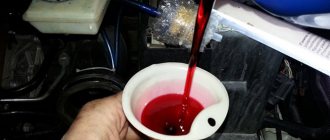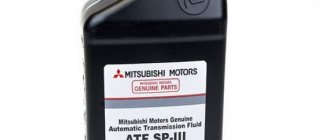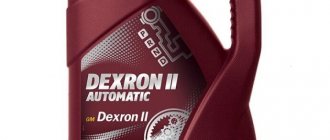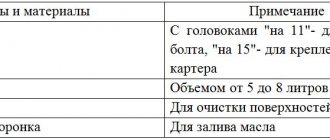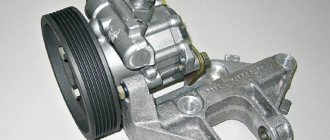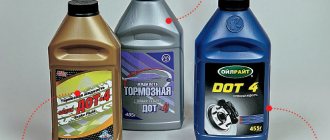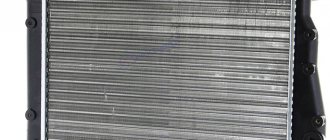What are there
The first liquid of this brand was developed by General Motors and released in 1968. The product was named Dexron; over time, this name grew into a trademark for special fluids produced for automatic transmissions and more.
The first Dextron was produced for 4 years, then stopped. One of the reasons was the use of whale oil in the composition. Conservationists protested against the killing of whales. In 1973, a law was passed prohibiting the use of animal or plant components obtained from rare species of animals and plants. The second reason was low fluid readings when the box was heated. It began to lose its lubricating properties.
In 1972, Dexron IIC was released. It was based on jojoba oil. The disadvantage was the appearance of corrosion of the cooling elements of the box. Already in 1975, the following modification was released, which included anti-corrosion additives. Products were labeled Dexron IID. The disadvantage of this is its hygroscopicity (the ability to absorb moisture from the air). Because of this, the fluid was no longer used in automatic transmissions.
The next step in the evolution was Dextron IIE. This liquid was no longer so hygroscopic. Produced in the period 1980-93. The main difference between IID and IIE was the basis. IID - has a mineral base, and the next generation is synthetic. Due to synthetics, IIE retains viscosity better at high/low temperatures and lasts longer.
Dexron III is a new word in the development of technology. It has much better properties of maintaining viscosity and fluidity. Today, it is this fluid that is used by most manufacturers in automatic transmissions. Its main advantage is the ability to interact (freely mix without loss of properties) with all previous generations of Dexron, and completely replace them.
Dexron VI was released in 2005. Which was developed for the new 6-range Hydra-Matic 6L80 gearbox. This box needed a fluid with high fluidity, increased lubricity and corrosion protection. The sixth Dextron differs from the third in its lower degree of viscosity at a temperature of 100 degrees. Dextron 6 has a rate of 6.5, and the third 7.5. Due to this, power losses due to friction are reduced and gasoline consumption is increased.
Looking for particles in the oil
A very important point. If foreign particles are found in the liquid itself - dirt and metal dust, or even shavings, this is a sign that our box is seriously worn out and requires repair. If your oil is in this condition, most likely you are already complaining about incorrect operation of the transmission.
And another thing is that the automatic transmission has its own oil filter, which retains these wear products, but when this filter becomes clogged, the box will begin to starve of oil. With all these problems together, it won’t seem enough to anyone, neither your box nor your wallet.
Imagine, if this filter is so “tired” that it is already allowing oil and debris into the system (after all, that’s where you took the oil from), then what happens to the units inside the automatic transmission?
But it was worth just changing the oil on time...
Results
You should not experiment with automatic transmissions, filling in different fluids and hoping for their compatibility. The best fluid for the machine is the one prescribed by the manufacturer. This will save you from expensive repairs, gear slipping, jerking, clicking and other troubles. The fact is that the parts are designed for a certain liquid, and the transition to even a higher quality and modern liquid can be disastrous for the parts.
Source
Speaking about transmission fluids, it should be noted that some automobile manufacturers developed their own tolerances and standards for these oils, which subsequently became generally accepted characteristics for companies specializing in the production of technical fluids for cars. These include the General Motors concern, which back in 1968 released the first transmission fluid for automatic transmissions ATF (Automatic Transmission Fluid) of its cars. The company's marketers gave this product the name Dexron, which became a registered trademark for a group of technical specifications for automatic transmission fluids. Under it, General Motors and other manufacturers of technical fluids still produce transmission oils for automatic transmissions.
The original Dextron fluid has been produced since 1968, but four years later General Motors was forced to stop producing it. There were two reasons: weak technical properties and... protest from environmentalists. The fact is that in the composition of Dextron-B, the manufacturing company used oil from whale sperm, which served as a friction modifier (friction modifier). Since whales are considered an endangered species of wild animals, the Endangered Species Act was passed in the United States in 1973, according to which it was prohibited to use any substances of rare species of flora and fauna in the production of industrial and food products. The second reason is purely technical. Whale oil did not withstand the high temperatures that developed in automatic transmissions produced in the 1970s and lost its essential properties as a friction modifier. Therefore, the management of General Motors decided to develop a different formula for Dextron, without whale oil. So in 1972, a new transmission fluid, Dexron IIC, appeared on the market, which contained jojoba oil as a friction modifier. But this product also turned out to be imperfect: its components caused corrosion of GM automatic transmission cooler parts. To avoid this, corrosion inhibitors were added to the fluid - additives that suppress the appearance of rust on automatic transmission parts and components. Dextron with such additives was called IID, and it entered the market in 1975. As in the case of its predecessor, Dexron IID was far from perfect: the corrosion inhibitor added to its composition provoked the hygroscopicity of the transmission fluid - it actively absorbed water vapor from the air and quite quickly lost its working properties. This is why Dextron IID is no longer used in vehicles with hydraulic systems. A further evolution of Dextron was the liquid labeled IIE, produced from the late 1980s to 1993. The manufacturer added new chemical additives to its composition, which made it possible to avoid the excessive hygroscopicity of Dextron. The differences between Dexron IID and Dexron IIE are their basis: the first is mineral, and the second is synthetic. Due to its synthetic “base”, Dextron IIE has the best performance characteristics - it maintains optimal viscosity at low temperatures and has an extended service life. The year 1993 was marked by the appearance of a new product on the gear oil market - Dexron III.
What kind of oil for automatic transmission? Which brand do you recommend? — logbook of Mitsubishi Pajero 1993 on DRIVE2
It's no secret that you only need to fill in ATF Dextron IID or ATF Dextron IIЕ, but whose production? Last time I filled it with MANNOL, the oil was lousy, the box was almost completely dead! Who can advise?
I will attach a short article about the interchangeability of dextron 2 and 3. The author of the text is naturally unknown.
A little theory
Automatic gearboxes (hereinafter referred to as automatic transmissions) use a special fluid, which is often called oil - ATF. Historically, the legislator in the field of setting standards in the field of automatic transmission fluids has been General Motors (GM), whose specifications are used by both ATF and automatic transmission manufacturers. So, in the 80s, the current GM specification was Dexron IID, which was then replaced by Dexron IIE, and in 1993 by Dexron III.
The only differences between Dexron IIE and Dexron IID are the low temperature viscosity. That is, at the operating temperature of the automatic transmission, there is practically no difference in the performance properties of IIE and IID. Well, except that IIE has greater stability of properties throughout its entire service life, since it is a completely synthetic fluid, and IID has a mineral base. However, at the very beginning of work, while the box has not yet warmed up, the differences are very significant - the viscosity of Dexron IID at -40°C is 45,000 mPa s, and Dexron IIE at the same temperature is 20,000 mPa s. From this we can see that it is much easier for the engine to turn the automatic transmission with Dexron IIE when “cold”. But between Dexron IID(E) and Dexron III there are differences in friction properties, which affect the operation of the automatic transmission in all operating modes.
Based on interchangeability, dexrons are grouped into groups, depending on equipment requirements:
Dexron III replaces Dexron II (but not vice versa) if the equipment allows for an increase in friction-reducing modifiers. This includes GM automatic transmissions. Dexron III does not replace Dexron II unless the equipment allows for a reduction in the coefficient of friction by increasing the efficiency of modifiers. Dexron IIE replaces Dexron IID on any equipment (but not vice versa), since it does not differ in the efficiency of modifiers and is actually Dexron 'om IID, but with improved low-temperature properties.
And practice
It is often quite difficult for a car enthusiast to understand what all these differences in low-temperature and friction properties mean in practice. It's actually quite simple. Dexron IID is not designed for use in cold winter conditions. It is suitable for regions where -15 C does not often occur. That is, its “habitat” is the south of the European part of Russia, Ukraine and non-northern Europe. Lower temperature areas
You will have to choose between Dexron IIE and Dexron III as they have more suitable low temperature viscosities. From here, it would seem, a logical conclusion follows for owners of cars with automatic transmissions who use Dextron II and live in “frosty” latitudes - they should “use” Dextron IIE. However, there may be a problem here, which is that the current specification is Dexron III, and all ATF manufacturers are focused on mass production of Dexron III. And for older cars they continue to produce Dexron IID. Why IID and not IIE? Because Dexron IIE is really needed only in the northern regions (where the bulk of the machines are not concentrated at all), and its production (let me remind you that it is a completely synthetic product) costs 2-3 times more. In other words, it makes economic sense for the ATF manufacturer to divide the entire fleet of vehicles into those who need Dexron IID and those who need Dexron III. As a result, buying a Dextron IIE can be a real problem. The transition point from II to III is usually taken as 1996. Here they (manufacturers) are well helped by the fact that GM allows the replacement of Dexron II with Dexron III. It turns out that we can safely recommend Dexron III to those who need good low-temperature properties instead of the “native” Dexron II. Is it really? It's hard to say for sure. Here everyone decides for himself. I will give only the possible consequences of replacing Dexron II with Dexron III in the case when the equipment does not allow a decrease in the friction properties of ATF:
an increase in gear shift time, that is, the gearbox will become more “thoughtful”, because the discs will slip longer than intended by the manufacturer due to the reduced friction properties of Dexron III. jerky nature of gear engagement – that is, the discs will slip and slip due to the reduced friction properties of Dexron III , and then, as the pressure of the liquid increases, bam and they “catch.”
www.drive2.ru
Characteristics of Dextron 2 and 3 - what are the differences
Dexron 2 and 3 fluids , which are used in power steering and automatic transmissions, lie in their fluidity rates, type of base oil, and temperature characteristics. In general terms, we can say that Dextron 2 is an older product released by General Motors, and accordingly, Dextron 3 is a newer one. However, you cannot simply replace the old fluid with a new one. This can only be done by observing the manufacturer’s tolerances, as well as the characteristics of the liquids themselves.
Classification of power steering fluids
Based on their composition, power steering fluids are divided into three types: mineral, semi-synthetic and synthetic.
Mineral ones contain 97% naphthenes and paraffins, as well as additives that give the liquids certain properties.
Semi-synthetics contain both mineral and synthetic components. Such oils have a longer service life and have better performance characteristics.
Synthetic PSF contains polyesters, petroleum fractions purified by hydrocracking, and polyhydric alcohols. In addition, they contain additives.
The manufacturer has introduced a classification of power steering fluids by color - red, yellow and green oils are obtained by adding coloring pigments.
Yellow oils are produced by Daimler. They are both mineral and synthetic. These oils are mainly used in Mercedes-Benz vehicles. Under license from Daimler, yellow PSF can also be produced by third parties.
Green liquids are products of the German concern Pentosin. They are recommended by automakers such as Peugeot, VAG, Citroen, etc. Green PSF can have any type of base. They are multifunctional, i.e. used not only in hydraulic boosters, but also in suspension systems, etc.
Red oils for power steering, which are called Dexron (Dexron), are developed according to the standards of the General Motors concern.
As a rule, their modern modifications (starting with Dexron IV) are completely synthetic.
Today, the most commonly used liquids are Dexron 3 and Dexron 4. General Motors does not produce Dexron 3; other companies produce them under license.
Generations of Dexron liquids and their characteristics
To understand what are the differences between Dexron II and Dexron III, as well as what is the difference in one and the other transmission fluid, it is necessary to briefly look at the history of their creation, as well as the characteristics that have changed from generation to generation.
Dexron II characteristics
This transmission fluid was first released by General Motors in 1973. Its first generation was called Dexron 2 or II C. It was based on mineral oil from the second group according to the API classification - American Petroleum Institute. In accordance with this standard, the base oils of the second group were obtained by using hydrocracking. In addition, they contain at least 90% saturated hydrocarbons, less than 0.03% sulfur, and also have a viscosity index ranging from 80 to 120.
The first additives that began to be added to transmission fluid were corrosion inhibitors. In accordance with the license and designation (Dexron IIC), the composition on the packaging is designated starting with the letter C, for example, C-20109. The manufacturer indicated that it is necessary to change the fluid to a new one every 80 thousand kilometers. However, in practice it turned out that corrosion occurs much faster, so General Motors began producing the next generation of its products.
Beginning in 1988, automakers began replacing automatic transmissions with hydraulic control systems with electronic ones. Accordingly, they needed a different lubricant for automatic transmissions, one with low viscosity, which provides a much higher rate of force transmission (response) due to better fluidity.
Dexron III characteristics
For Dextron 3 transmission fluids, the base oils belong to group 2+ , which is characterized by increased class 2 characteristics; in particular, the hydrotreating method is used in production. The viscosity index here is increased , and its minimum value ranges from 110...115 units and above . That is, Dexron 3 has a completely synthetic base .
The first generation was Dexron-III (F) . In fact, this is just an improved version of Dexron-II (E) with the same temperature ratings of -30°C. The disadvantages include low durability and poor shear stability, and fluid oxidation. This composition is designated with the letter F at the beginning, for example, F-30001.
The second generation - Dexron-III (G) , appeared in 1998. The improved composition of this fluid has completely overcome the problems of vibration when the car is moving. The manufacturer also recommended it for use in hydraulic power steering (power steering), some hydraulic systems, as well as in rotary air compressors where a high level of fluidity at low temperatures is required.
Advantages and disadvantages
MANNOL ATF Dextron 3 provides the following advantages during its operation:
- balanced composition providing optimal technical characteristics under any operating conditions;
- excellent frictional properties when switching gears, leveling jerks and hesitations;
- excellent properties at low temperatures;
- stability to oxidation and chemical attack;
- preservation of all properties throughout the entire service interval;
- safety for seal materials.
You can also find sharply negative reviews about this lubricant on the Internet. However, the overwhelming majority are positive. As a significant advantage, many users emphasize that the liquid can be bought almost everywhere and at a very affordable price. Defects that arise during product operation are most likely due to specification violations.
Differences between Dexron 2 and Dexron 3 and replaceability
The most popular questions regarding the operation of Dexron 2 and Dexron 3 transmission fluids are whether they can be mixed and whether one oil can be used instead of the other. Since improved characteristics should undoubtedly affect the improvement of the operation of the unit (be it power steering or automatic transmission).
Difference between Dexron 2 and Dexron 3 for automatic transmission
Before adding or mixing different types of transmission fluids, you need to find out what type of fluid the car manufacturer recommends using. Usually this information is in the technical documentation (manual); for some cars (for example, Toyota) it may be indicated on the gearbox dipstick.
Ideally, only a lubricant of the specified class should be poured into an automatic transmission, despite the fact that from class to class of liquid there have been improvements in characteristics that affect the duration of its operation. Also, do not mix, observing the frequency of replacement (if replacement is envisaged at all, since many modern automatic transmissions are designed to operate with one fluid throughout the entire period of their operation, only with the addition of fluid as it burns out).
Next, you need to remember that mixing liquids based on mineral and synthetic bases is allowed with restrictions! So, in an automatic transmission they can be mixed only if they contain the same type of additives. In practice, this means that you can mix, for example, Dexron II D and Dexron III only if they were produced by the same manufacturer. Otherwise, chemical reactions may occur in the automatic transmission with the formation of sediment, which will clog the thin channels of the torque converter, which can lead to its malfunction.
Interchangeability of Dexron 3 with other lubricants
Replacing the abs sensor: types, types, principles of operation and causes of failure
Is it possible to mix Dextrons from different manufacturers and with different indexes? Let's answer this question briefly.
In automatic transmissions, it is advisable to use only those transmission fluids recommended by the manufacturer. However, on forums and even serious service stations, technicians often recommend cheaper or more accessible analogues.
But such a replacement will not always be correct. For example, it is better not to change Toyota’s specialized Dextron 3 oil, intended for Asian cars, to Mobile Dextron 3 unless there is reliable information about the possibility of such a replacement.
Even with confirmation of certificates from GM, external similarity and similar viscosity. Although the JASO standard for the Japanese automobile industry was created, including on the developments of GM.
For example, if, according to the requirements of the car manufacturer, Dexron 2 series oil must be poured into the box, then you can safely use any version of Dexron 3 lubricants.
The differences between Dextron 2 and 3 in all parameters show improved performance with increasing index. The same goes for Dexron 6 series oils.
It is better not to downgrade the lubricant. This will negatively affect transmission parts within a fairly short period of time.
As for power steering, similar rules apply here. However, you can fill in any other liquid for a short time if it is not possible to purchase a suitable one.
Operating the hydraulic booster dry will have greater negative consequences for the power steering than with unsuitable oil. About the standards of transmission lubricant Dextron 2,3,6 - video
The operating principle of automatic transmission and power steering is based on the operation of fluids, such as ATF Dexron 3. Lubricants from different manufacturers are sold with a similar name. Oils vary in composition, characteristics and performance. Familiarization with the Dextron specification will help you navigate the diversity and choose the best product.
The difference between Dexron and ATF
In terms of the interchangeability of fluids, car owners also wonder not only about the compatibility of Dexron 2 3, but also what is the difference between Dextron 2 oil and ATF. In fact, this question is incorrect, and here's why... The abbreviation ATF stands for Automatic Transmission Fluid, which means automatic transmission fluid. That is, all transmission fluids used in automatic transmissions fall under this definition.
As for Dexron (regardless of generation), it is just a name for a group of technical specifications (sometimes referred to as a brand) for automatic transmission fluids created by General Motors (GM). This brand produces not only fluids for automatic transmissions, but also for other mechanisms. That is, Dexron is a generic name for specifications that have been adopted over time by various manufacturers of their respective products. Therefore, you can often find the designations ATF and Dexron on the same canister. After all, in fact, Dextron fluid is the same transmission fluid for automatic transmissions (ATF). And they can be mixed, the main thing is that their specifications belong to the same group. As for the question of why some manufacturers write Dexron on canisters and others ATF, the answer comes down to the same definition. Dexron fluids are manufactured to General Motors specifications, while others are manufactured to other manufacturers' specifications. The same applies to the color marking of canisters. It in no way indicates a specification, but only informs (and not always) what type of oil was used as a base oil in the production of a particular transmission fluid presented on the counter. Typically, red means that the base used was mineral oil, and yellow means that it was synthetic.
Source
Characteristics and scope of application of Dexron 3 oils
One of the questions that many people get confused about is: Is Dextron 3 synthetic or mineral water? The first two versions (IIIF and IIIG) are pure mineral water. The latest modification, IIIH, is rather semi-synthetic, as it is made from bases of classes 2 and 3 according to API.
The viscosity of Dexron 3 lubricants is distinguished by its stability. With changes in temperature and during the general aging of the oil, the viscosity changes its parameters slightly.
The working viscosity for lubricants in this category is in the range from 7 to 7.5 cSt. That is, Dextron 3 oils in automatic transmissions can serve for a long time without replacement due to loss of viscosity properties.
In general, all Dexron lubricants that have been certified by General Motors are suitable for use in all automatic transmissions designed for this lubricant.
It is important to ensure that a certificate is actually obtained for a particular lubricant, since key characteristics may differ for non-certified lubricants. In this case, the manufacturer may write on the canister that the oil is Dexron. To determine whether the lubricant meets the standards, you can refer to the list of certified manufacturers, which is posted on the company’s official website
For example, among domestic manufacturers, ATF oil Lukoil Dextron 3 is certified
To determine whether a lubricant meets the standards, you can refer to the list of certified manufacturers, which is posted on the company’s official website. For example, among domestic manufacturers, ATF oil Lukoil Dextron 3 is certified.
Areas of application for Dextron III oil:
- Today, GM transmission oils are used not only as ATP fluids. In addition to use in automatic transmissions, Dextron 3 lubricants are used for other purposes.
- Power steering fluid. Dextron 3 oils are often poured into the power steering. Almost all Asian and many European cars use lubricants similar to Dextron III ATF greases, or with similar compositions.
- Mechanical gearboxes, gearboxes, transfer cases, axles and other loaded transmission units. Dextron 3 oils are often used for these units.
- Industrial oils. Some industrial equipment components also use fluids developed by GM.
- Hydraulic oils. Due to their high and stable properties with minimal temperature dependence, Dexron lubricants are used in actuators of hydraulic equipment.
